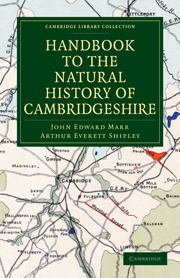PHYSIOGRAPHY
Published online by Cambridge University Press: 10 November 2010
Summary
The county of Cambridge is about fifty miles in length from north to south, and its greatest breadth from east to west is about thirty miles; it occupies an area of eight hundred and sixty square miles. The greater part of the county is drained by the river Ouse and its tributaries, of which the Cam is the principal, while the northern part is traversed by a portion of the Nen and its tributaries.
Along part of its course the old Ouse river ran in a direction somewhat north by east from St Ives, past Ely, dividing the county into two portions, of which the northern is almost entirely composed of fenland, while the southern is largely occupied by more elevated ground.
In accordance with its geological structure the county is divisible into three important areas, and two minor ones. The former consist of (i) the chalk tract which lies to the east of the Cam between the southern part of the county and Waterbeach, (ii) the curiously dissected plateau which occupies the south-western part of the county between the valleys of the Cam and Ouse, and (iii) the Fenland of the northern part of the county. The minor tracts consist of the alluvial belts which border the Cam and its tributaries and the ridges of old river gravels; and a small plateau topped by gravels which occupies the country around Fordham, Chippenham, and Newmarket.
- Type
- Chapter
- Information
- Publisher: Cambridge University PressPrint publication year: 2010First published in: 1904

